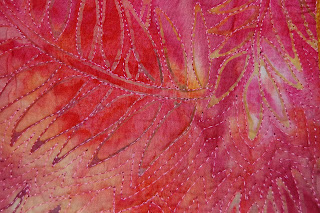After Hannah disassembled the day bed upstairs and rearranged her room, she left a pile of bedding for me to contend with. Among the items is Sarah's quilt that she made in 2002, a purple and yellow twin sized quilt (Pattern: Yellow Brick Road by Atkinson Designs).
I decided to give it a soak and spin through the washing machine. I don't put a quilt through much of the machine's agitation/wash cycle because I am able to manipulate the dials and shorten the process. This helps the fiber in the fabric of the quilt to last longer, especially for those quilts that are getting daily use.
First step is to fill the washing machine with warm water. As it it filling, add some quilt soap. I use sodium lauryl sulfate which is a hard white soap that softens with heat. I open the jar of soap and let the machine's water fill the jar and then I dump it into the machine. I do this a few times to liquify enough soap, equivalent to about a tablespoon of soap. You can also spoon a tablespoon of the hard soap into the machine and the warm water will melt it.

When the machine has filled with water and begins to agitate to mix the soap, I push in the machine's button to stop the agitation. I lay the quilt in the machine and submerge it in the water. Then I let the quilt soak for about an hour. Then I move the machine's dial just a bit to the right, pull the dial back out so the machine will spin out the water. It then refills for the rinse cycle. There is agitation in the rinse cycle so I skip that and turn the dial to the final spin cycle. A minute or two of agitation is fine but putting the quilt through the entire cycle will eventually cause the quilt to wear out.

Once the soaking/spinning is complete, I put the quilt in the dryer on extra low heat for delicates and dry for 10-20 minutes. The quilt will not be completely dry but it will be dry enough to finish air-drying over a couch, chair, or bed. Just rotate the quilt until it is dry. On a warm day, air-drying outside will work well. Use a sheet to cover an outside area and lay the quilt on that. Just be careful if there are pets around. Avoid hanging a damp quilt to dry; it can be easily distorted this way.
Copyright
©2013, Sharon Baggs























